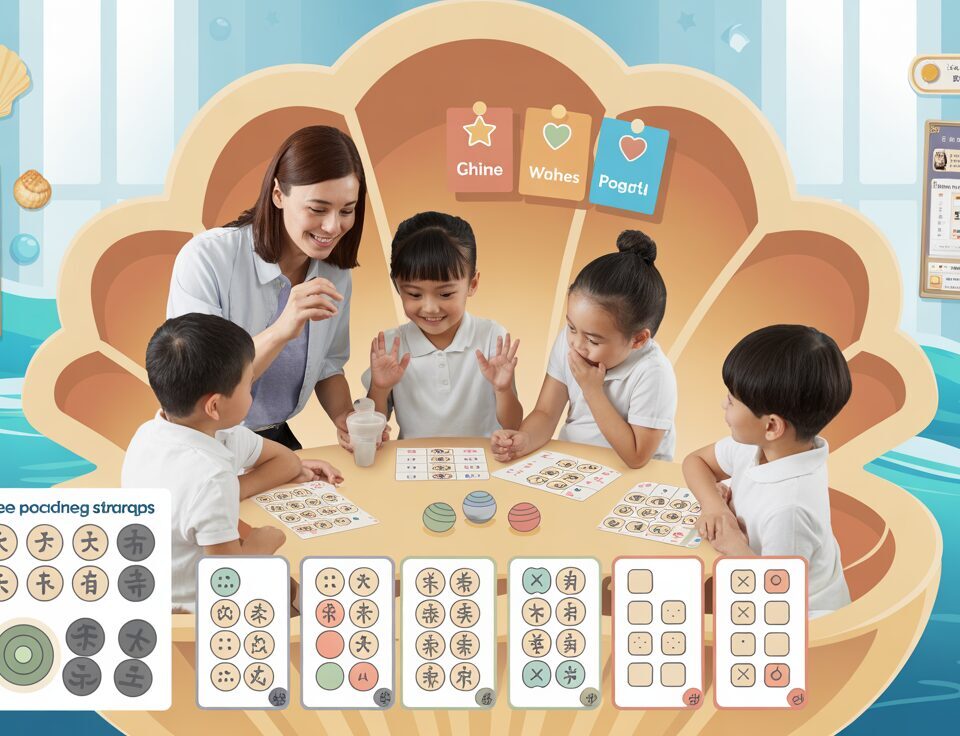
Build a Water-Cycle Model: Step-by-Step Video Guide for Primary School Science
October 25, 2025
Fun Kitchen Density Experiments for Primary School Science Success
October 27, 2025Table Of Contents
The PSLE Science examination presents a unique challenge for Primary 6 students, with open-ended questions often becoming the deciding factor between an AL1 and AL2 grade. Unlike MCQs that test recall, open-ended questions require students to demonstrate understanding, application, and communication of scientific concepts clearly and precisely.
At Seashell Academy by Suntown Education Centre, we’ve observed that even academically strong students can struggle with articulating their knowledge effectively in open-ended questions. The challenge isn’t just about knowing the science—it’s about expressing that knowledge in a way that earns full marks.
In this comprehensive guide, we’ll share our proven Seashell Method for tackling open-ended questions in PSLE Science. Drawing from our experience helping hundreds of students achieve excellence, these techniques combine strategic thinking with effective communication skills, ensuring your child can transform their scientific understanding into perfect answers that examiners are looking for.
Understanding Open-Ended Questions in PSLE Science
Open-ended questions in PSLE Science typically account for 40-45% of the total marks but often determine the difference between achieving an AL1 or AL2. These questions require students to construct responses using their own words rather than selecting from provided options.
The primary purpose of these questions is to assess students’ ability to:
- Apply scientific concepts to real-world situations
- Demonstrate depth of understanding beyond memorization
- Articulate scientific reasoning clearly and logically
- Make connections between different scientific concepts
- Use scientific vocabulary and terminology appropriately
Examiners are looking for specific keywords, logical reasoning, and clear communication. A common misconception is that lengthy answers score better marks—in reality, precision and accuracy are much more important than length.
Common Challenges Students Face
Through our years of teaching at Seashell Academy, we’ve identified several recurring challenges that students encounter when answering open-ended questions:
Misinterpreting what the question is asking: Many students rush into answering without fully understanding what information the question is seeking. This often results in answers that are factually correct but don’t address the specific question.
Incomplete answers: Students frequently provide only partial explanations, missing key points that would earn them full marks. For example, in questions about heat transfer, they might mention conduction but forget to explain how it applies to the specific scenario.
Poor structure and organization: Even when students know the correct information, disorganized answers can lose marks. A logical sequence of ideas is essential for clear communication.
Lack of scientific vocabulary: Using everyday language instead of scientific terms can result in imprecise answers that don’t fully demonstrate understanding.
Exam anxiety affecting recall: The pressure of the examination can cause students to forget concepts they’ve mastered during practice sessions.
The Seashell Method for Answering Open-Ended Questions
At Seashell Academy, we’ve developed the Seashell Method—a systematic approach that helps students tackle any open-ended question with confidence. This method forms part of our unique Programme Philosophy that balances academic excellence with student well-being.
Step 1: Decode the Question
The first step is to carefully analyze what the question is asking:
Identify the command words: Different instructions require different types of responses:
- “Explain” requires you to give reasons for something
- “Describe” asks you to state what something looks like or what happens
- “Compare” means you should discuss similarities and differences
- “Predict” requires you to say what might happen based on scientific principles
Circle key information: Identify the scientific scenario, variables, or observations mentioned in the question.
Determine the marks allocated: The number of marks indicates how many distinct points you need to make. As a rule of thumb, aim to provide one relevant scientific point for each mark available.
Step 2: Identify Key Scientific Concepts
Once you understand what the question is asking, recall the relevant scientific concepts:
Topic identification: Determine which area of the syllabus the question relates to (e.g., heat and temperature, forces, ecosystems).
Mental mind-mapping: Quickly recall key principles and relationships within that topic. At Seashell Academy, we teach students to create mental mind maps that help them retrieve information efficiently during exams.
Contextual application: Consider how these scientific concepts apply to the specific scenario in the question.
Step 3: Structure Your Answer
A well-structured answer is easier for examiners to follow and ensures you don’t miss key points:
Point-Evidence-Explanation (PEE) approach:
- Point: State the key scientific principle or concept
- Evidence: Reference the specific elements from the question scenario
- Explanation: Connect the principle to the evidence, showing how the concept applies
For example, if explaining why a metal spoon heats up faster than a wooden spoon:
Point: Metal is a good conductor of heat.
Evidence: The metal spoon is in contact with the hot soup.
Explanation: Heat energy transfers quickly through the metal spoon by conduction, causing the metal spoon to heat up faster than the wooden spoon.
Step 4: Apply Scientific Language
Using appropriate scientific terminology demonstrates your understanding and earns more marks:
Use precise scientific vocabulary: Instead of saying “the plant makes food,” use “the plant undergoes photosynthesis to produce glucose.”
Include cause and effect relationships: Use connecting phrases like “this causes,” “as a result,” “this leads to,” or “because of this” to show the relationship between scientific phenomena.
Be specific with units and measurements: Always include appropriate units (e.g., Newtons for force, degrees Celsius for temperature).
Step 5: Review Your Answer
Before moving on to the next question, quickly check your answer:
Verification check: Have you directly answered what the question asked?
Completeness check: Have you provided enough points to match the marks allocated?
Accuracy check: Are your scientific facts and concepts correct?
Language check: Have you used appropriate scientific terminology?
Mastering Different Types of Open-Ended Questions
Different types of open-ended questions require slightly different approaches. Here’s how to tackle the most common types:
Explain Questions
“Explain” questions typically ask you to give reasons for scientific phenomena or observations.
Strategy:
- Identify the scientific principle involved
- Describe how this principle works in general
- Apply the principle to the specific context in the question
- Outline the cause-effect relationship clearly
Example: “Explain why sweating helps to cool the body down.”
When a person sweats, water (sweat) is produced on the skin surface. Heat energy from the body is absorbed by the water molecules, causing them to gain energy and evaporate from the skin surface. This process of evaporation requires heat energy from the body, resulting in the cooling of the body.
Compare Questions
“Compare” questions ask you to identify similarities and/or differences between two things.
Strategy:
- Organize your answer using a point-by-point comparison
- Ensure you address both similarities and differences unless otherwise specified
- Use comparative language (“both,” “whereas,” “unlike,” “similar to”)
- Support comparisons with scientific reasoning
Example: “Compare how heat is transferred through metal and plastic.”
Heat transfers through both metal and plastic by conduction. However, metal is a good conductor of heat, allowing heat energy to transfer quickly as the free electrons move and collide with neighboring particles. In contrast, plastic is a poor conductor (insulator), so heat transfers much more slowly as the particles only vibrate in fixed positions.
Predict Questions
“Predict” questions ask you to apply scientific principles to forecast an outcome.
Strategy:
- State your prediction clearly
- Identify the relevant scientific principle
- Explain how this principle applies to the given scenario
- Justify why your prediction follows from the principle
Example: “Predict what would happen to the rate of photosynthesis if a plant was moved from dim light to bright sunlight.”
The rate of photosynthesis would increase when the plant is moved from dim light to bright sunlight. This is because light intensity is a limiting factor in photosynthesis. With increased sunlight, more light energy is available for the chlorophyll in the plant to absorb. This additional energy allows the plant to convert more carbon dioxide and water into glucose at a faster rate, thus increasing the rate of photosynthesis.
Design Questions
“Design” questions ask you to create an experiment or solution based on scientific principles.
Strategy:
- State the aim of your design clearly
- List materials and equipment needed
- Describe the procedure step-by-step
- Explain how your design applies scientific principles
- Mention how you would measure or observe results
- Include at least one control variable if designing an experiment
Example: “Design an experiment to test which material is the best insulator.”
Aim: To determine which material is the best insulator.
Materials: 3 identical containers, hot water, thermometer, stopwatch, different insulating materials (e.g., bubble wrap, cotton wool, aluminum foil).
Procedure:
1. Wrap each container with a different insulating material, leaving one container unwrapped as a control.
2. Pour the same amount of hot water (at the same starting temperature) into each container.
3. Record the initial temperature of the water in each container.
4. Measure and record the temperature of the water every 5 minutes for 30 minutes.
5. Calculate the temperature decrease for each container.
The material that results in the smallest temperature decrease is the best insulator as it prevents heat from transferring to the surroundings most effectively.
Effective Practice Strategies
At Seashell Academy, we emphasize that consistent, deliberate practice is key to mastering open-ended questions. Here are strategies we recommend to our students:
Create a concept dictionary: Compile key scientific terms, definitions, and examples in a notebook or digital document. Review this regularly to reinforce vocabulary.
Practice with past papers: Work through previous PSLE Science papers, focusing specifically on the open-ended sections. Time yourself to simulate exam conditions.
Use the mark scheme: After attempting questions, review the mark scheme to understand what examiners are looking for. Identify gaps in your knowledge or expression.
Group study sessions: Explain concepts to peers or parents. Teaching others reinforces your own understanding and highlights areas where your explanations could be clearer.
Topic-by-topic mastery: Rather than trying to cover everything at once, focus on mastering one topic area before moving to the next. This builds confidence and thorough understanding.
In our Mathematics Programme, we apply similar methodical approaches to problem-solving, emphasizing both technical skills and conceptual understanding, which helps students excel across different subjects.
Common Mistakes to Avoid
Being aware of common pitfalls can help students avoid losing unnecessary marks:
Not reading the question carefully: Many students lose marks by answering what they think the question is asking rather than what it’s actually asking. Always read twice before answering.
Providing generic answers: Answers must be specific to the context provided in the question. Generic explanations without application to the scenario will not earn full marks.
Omitting scientific terminology: Using everyday language instead of scientific vocabulary suggests a lack of understanding and results in lost marks.
Writing too much irrelevant information: While thoroughness is important, including irrelevant information wastes valuable time and can even lead to contradictory statements that cost marks.
Not matching points to marks available: If a question is worth 3 marks, you need to make at least 3 distinct, relevant points. Missing this basic guideline is a common reason for lost marks.
Case Studies: Before and After Examples
To illustrate the effectiveness of the Seashell Method, let’s examine some before-and-after examples from our students:
Case Study 1: Electricity Question
Question: “Explain why the bulb in Circuit A glows brighter than the bulb in Circuit B.” (2 marks)
Before (Student’s initial answer):
The bulb is brighter because Circuit A has more power than Circuit B. The electricity flows better in Circuit A.
After applying the Seashell Method:
Circuit A has only one bulb while Circuit B has two bulbs connected in series. When connected in series, the same current flows through both bulbs in Circuit B, dividing the electrical energy between them. In Circuit A, all the electrical energy is used by the single bulb, causing it to glow brighter.
Case Study 2: Forces Question
Question: “Predict what will happen to a toy car’s speed when it moves from a smooth tile floor onto a carpet. Explain your answer.” (3 marks)
Before (Student’s initial answer):
The car will slow down on the carpet because carpet is rougher than the floor, so it’s harder for the car to move.
After applying the Seashell Method:
The toy car’s speed will decrease when it moves from the smooth tile floor onto the carpet. This is because the carpet has a rougher surface than the tile floor, resulting in increased friction between the car’s wheels and the carpet. This increased frictional force opposes the motion of the car, causing it to decelerate and move more slowly across the carpet surface.
These examples demonstrate how applying the Seashell Method transforms basic answers into comprehensive, scientifically-precise explanations that earn full marks.
At Seashell Academy, our P6 Chinese Programme also emphasizes similar structured approaches to answering techniques, helping students excel across different subjects.
Conclusion
Mastering open-ended questions in PSLE Science is not just about knowing scientific facts—it’s about developing the skills to communicate that knowledge effectively. The Seashell Method provides a structured approach that helps students decode questions, identify relevant concepts, structure their answers logically, and use appropriate scientific language.
At Seashell Academy by Suntown Education Centre, we believe in nurturing students holistically, combining academic excellence with emotional well-being. Our approach to Science education, like our P4 Chinese and P5 Chinese programmes, focuses on building both knowledge and confidence through structured learning plans and interactive lessons.
By practicing these techniques consistently and avoiding common pitfalls, students can approach PSLE Science open-ended questions with confidence, transforming what was once a challenging aspect of the exam into an opportunity to showcase their scientific understanding.
Remember, the journey to mastery is a process that requires patience and practice. With the right techniques, guidance, and mindset, every student can excel in PSLE Science and develop a genuine appreciation for scientific thinking that extends far beyond examinations.
Ready to Help Your Child Master PSLE Science?
At Seashell Academy by Suntown Education Centre, we specialize in nurturing Primary 1-6 students through our unique Seashell Method. Our experienced MOE-trained educators provide personalized coaching in small classes, helping students develop both academic excellence and confidence.
Book a consultation with our Science specialists to discover how we can help your child master open-ended questions and achieve their full potential in PSLE Science.





